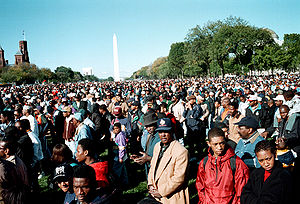- Crowd counting
-
 The Million Man March, Washington, D.C., October 1995 was the focus of a large crowd counting dispute.
The Million Man March, Washington, D.C., October 1995 was the focus of a large crowd counting dispute.
Crowd counting is a technique used to count or estimate the number of people in a crowd. At ticketed events, turnstiles are often used to precisely count the number of people entering a venue. At unticketed events, especially events that take place in the streets or a park rather than an enclosed venue, crowd counting is more difficult and less precise. For many events, especially political rallies or protests, the number of people in a crowd carries political significance and count results are controversial. For instance, the global protests against the Iraq war saw many protests at which widely differing counts were offered by organizers on one side and the police on the other. Another memorable incident occurred when Louis Farrakhan threatened to sue the Washington, D.C. Park Police for announcing that only 400,000 people attended the 1995 Million Man March he organized.
Jacobs's Method
The most common technique for counting crowds at protests and rallies is Jacobs's Method, named for its inventor, Herbert Jacobs. Jacobs method involves dividing the area occupied by a crowd into sections, determining an average number of people in each section, and multiplying by the number of sections occupied. According to a report by Life's Little Mysteries, technologies sometimes used to assist such estimations include "lasers, satellites, aerial photography, 3-D grid systems, recorded video footage and surveillance balloons, usually tethered several blocks around an event's location and flying 400 to 800 feet (120 to 240 meters) overhead."[1]
References
- ^ Melina, Remy (September 3, 2010). "How Is Crowd Size Estimated?". Life'sLittleMysteries.com. http://www.lifeslittlemysteries.com/how-is-crowd-size-estimated--1074/.
External links
Categories: Crowds | Protests
Wikimedia Foundation. 2010.
